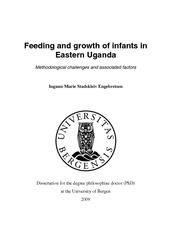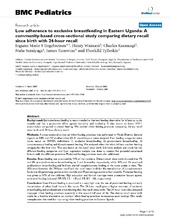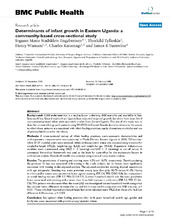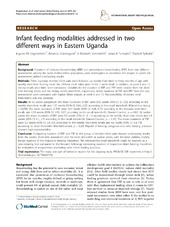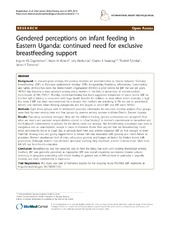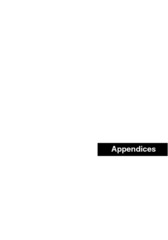| dc.contributor.author | Engebretsen, Ingunn Marie S. | en_US |
| dc.date.accessioned | 2010-11-25T17:28:03Z | |
| dc.date.available | 2010-11-25T17:28:03Z | |
| dc.date.issued | 2009-09-29 | eng |
| dc.identifier.isbn | 9788230808627 | en_US |
| dc.identifier.uri | https://hdl.handle.net/1956/4319 | |
| dc.description.abstract | Introduction: Exclusive breastfeeding (EBF) is established as the safest feeding method in the first half of infancy. Mixing breast milk and other foods, including nonhuman milk and semi-solid foods (MF), before 6 months carries an increased risk of child mortality compared to EBF due to infectious diseases. Replacement feeding (RF) is only recommended for HIV-1 positive mothers when it is acceptable, feasible, affordable, sustainable and safe (AFASS). This thesis assesses infant feeding practices, growth and related factors in Mbale, Eastern Uganda, where infant mortality rate is ~80/1000 and adult HIV-1 prevalence is 5-6 %. Methods: The thesis comprises: 1) a cross-sectional survey of 727 mother-infant pairs (paper I and II); 2) a follow-up study of 30 mother-infant pairs seen weekly for 12 weeks after birth (paper III); and 3) 8 focus group discussions, 4 among men and 4 among women (paper IV). From the cross-sectional survey, infant feeding practices - according to dietary recall since birth and the 24-hour dietary recall - were assessed in addition to early infant feeding practices and associated factors. Infant anthropometric status, including determinants for undernutrition, is presented in relation to feeding practices and sociodemographic characteristics. From the follow-up study, feeding modalities yielded from weekly assessments were compared to those obtained from the dietary recall since birth, being conducted at weeks 6 and 12 post-partum using Kaplan-Meier analysis. Perceptions of both fathers and mothers regarding infant feeding practices have been addressed in the focus group discussions, and inductive content analysis was used. This thesis combines the quantitative and qualitative studies under the ‘mixed methods approach.’ Results: The main finding was that despite universal breastfeeding EBF was scarcely practiced. Dietary recall from the survey showed that 7% and 0% practiced EBF at 3 and 6 months, respectively. The feeding modalities obtained from the 24-hour recall versus recall since birth showed discrepancies. The EBF prevalence was much higher according to the 24-hour recall than the recall since birth. Pre-lacteal feeds were given to 57% of the infants in the survey, and it was widely accepted according to the qualitative findings. Breast milk was often perceived as ‘not enough’ from birth. In the survey half of the mothers had not initiated breastfeeding within two hours, and still after the first day a quarter had not initiated it. Initiation of breastfeeding was delayed for a variety of reasons; the qualitative findings emphasized hygiene procedures and traditions. Insufficient supplementary feeding occurred in the second half of infancy. S tunting increased with age: of the infants in the survey alone, 17% were stunted. Fewer girls than boys were stunted (41% versus 59%, OR 0.6 95% CI 0.4 – 0.97). Low wealth status was associated with decrease in linear growth as well as sub-optimal infant feeding practices. The feeding modalities obtained from the prospective weekly follow-up showed a similar pattern as the results obtained from the recall since birth at 3 months, but estimates from the recall since birth were slightly longer (~1 week). At 12 weeks post-partum, the mean duration for ending EBF and starting predominant breastfeeding (PBF), by introducing water liquids and fruit juices, was 0.5 weeks (95% CI 0-1.1 weeks) according to the frequent short-time recalls, and 1.4 weeks (95% CI 0.1-2.7 weeks) for the recall since birth (Mantel-Cox-test, p=0.15). The mean time for ending PBF and starting MF was 5.2 weeks (95% CI 3.9 – 6.5 weeks) according to the frequent shorttime recalls, and 6.6 weeks (95% CI 5.4-7.8 weeks) for the recall since birth (Mantel-Cox-test, p=0.20). Even if the health system conveyed the concept of ‘exclusive breastfeeding’, mothers did not seem to have an ‘internalised knowledge’ of it and why it was promoted. An illustrative quote from the discussions among mothers was: ‘I want to know why they refuse us to give other feeds during the first six months.’ Men felt left out of the children’s health education, and said they had learnt ‘nothing.’ Not undertaking breastfeeding was seen as unacceptable in the qualitative study, except for maternal illness, and it was socially sanctioned. Verbal accusation, physical violence and even divorce could be the result of a non-breastfeeding decision according to the qualitative analysis. Conclusion: Sub-optimal feeding practices and high stunting rates were seen. Dietary recall since birth provides an informative tool for recording infant feeding modalities. Poverty was strongly associated with impaired growth and suboptimal infant feeding practices, and parents expressed confusion and difficulties adhering to the recommended feeding practices. Hindrances experienced by the mothers to practice recommended infant feeding practices, including EBF, need to be taken into consideration, and the involvement of fathers is imperative. | en_US |
| dc.language.iso | eng | eng |
| dc.publisher | The University of Bergen | eng |
| dc.relation.haspart | Paper I: BMC Pediatrics 7(10), Engebretsen, I. M. S.; Wamani, H.; Karamagi, C. A.; Semiyaga, N.; Tumwine, J. K.; Tylleskär, T., Low adherence to exclusive breastfeeding in Eastern Uganda: a community-based cross-sectional study comparing dietary recall since birth with 24-hour recall. Copyright 2007 Engebretsen et al; licensee BioMed Central. Reproduced with permission. Published version. The published version is also available at: <a href="http://dx.doi.org/10.1186/1471-2431-7-10" target="_blank">http://dx.doi.org/10.1186/1471-2431-7-10</a> | en_US |
| dc.relation.haspart | Paper II: BMC Public Health 8(418), Engebretsen, I. M. S.; Tylleskär, T.; Wamani, H.; Karamagi, C.; Tumwine, J. K., Determinants of infant growth in Eastern Uganda: a community-based crosssectional study. Copyright 2008 Engebretsen et al; licensee BioMed Central. Reproduced with permission. Published version. The published version is also available at: <a href="http://dx.doi.org/10.1186/1471-2458-8-418" target="_blank">http://dx.doi.org/10.1186/1471-2458-8-418</a> | en_US |
| dc.relation.haspart | Paper III: International Breastfeeding Journal 5(2), Engebretsen, I. M. S.; Shanmugam, R.; Sommerfelt, A. E.; Tumwine, J. K.; Tylleskär, T., Infant feeding modalities addressed in two different ways in Eastern Uganda. Copyright 2010 Engebretsen et al; licensee BioMed Central. Reproduced with permission. Published version. The published version is also available at: <a href="http://dx.doi.org/10.1186/1746-4358-5-2" target="_blank"> http://dx.doi.org/10.1186/1746-4358-5-2</a> | en_US |
| dc.relation.haspart | Paper IV: International Breastfeeding Journal 5(13), Engebretsen, I. M. S.; Moland, K. M.; Nankunda, J.; Karamagi, C. A.; Tylleskär, T.; Tumwine, J., 'No newborn feeds on breast milk only:' perceptions on infant feeding among fathers and mothers in Eastern Uganda. Published as: Gendered perceptions on infant feeding in Eastern Uganda: continued need for exclusive breastfeeding support. Copyright 2010 Engebretsen et al; licensee BioMed Central. Reproduced with permission. Published version. The published version is also available at: <a href="http://dx.doi.org/10.1186/1746-4358-5-13" target="_blank"> http://dx.doi.org/10.1186/1746-4358-5-13</a> | en_US |
| dc.title | Feeding and growth of infants in Eastern Uganda. Methodological challenges and associated factors | en_US |
| dc.type | Doctoral thesis | |
| dc.rights.holder | Copyright the author. All rights reserved | |
| dc.rights.holder | The author | |
| dc.subject.nsi | VDP::Medisinske Fag: 700::Klinisk medisinske fag: 750::Pediatri: 760 | nob |
